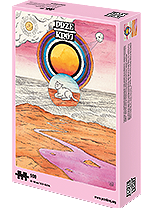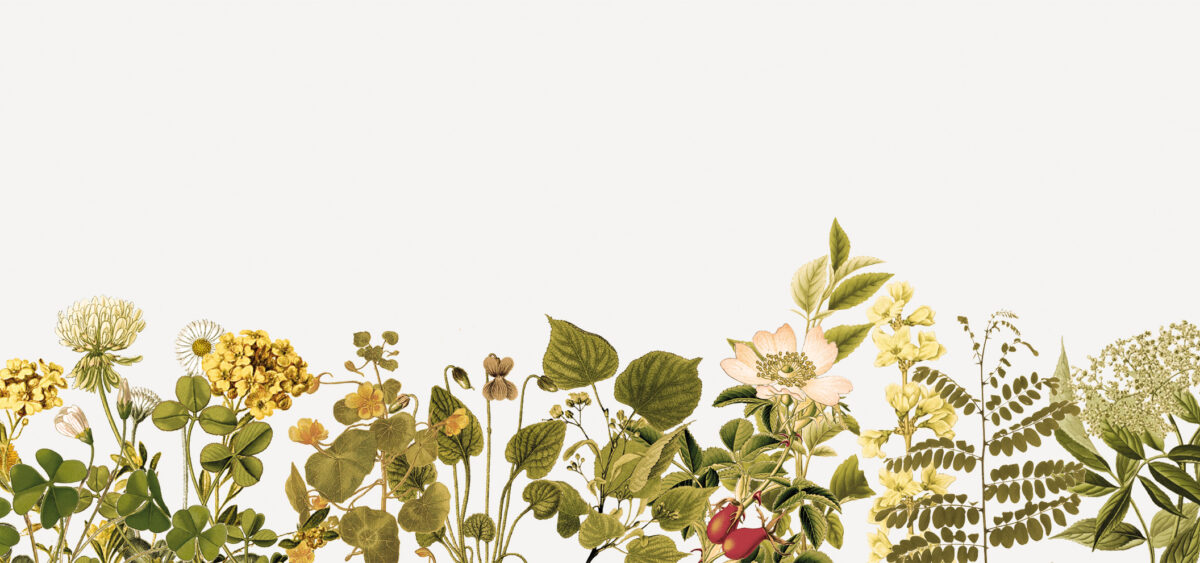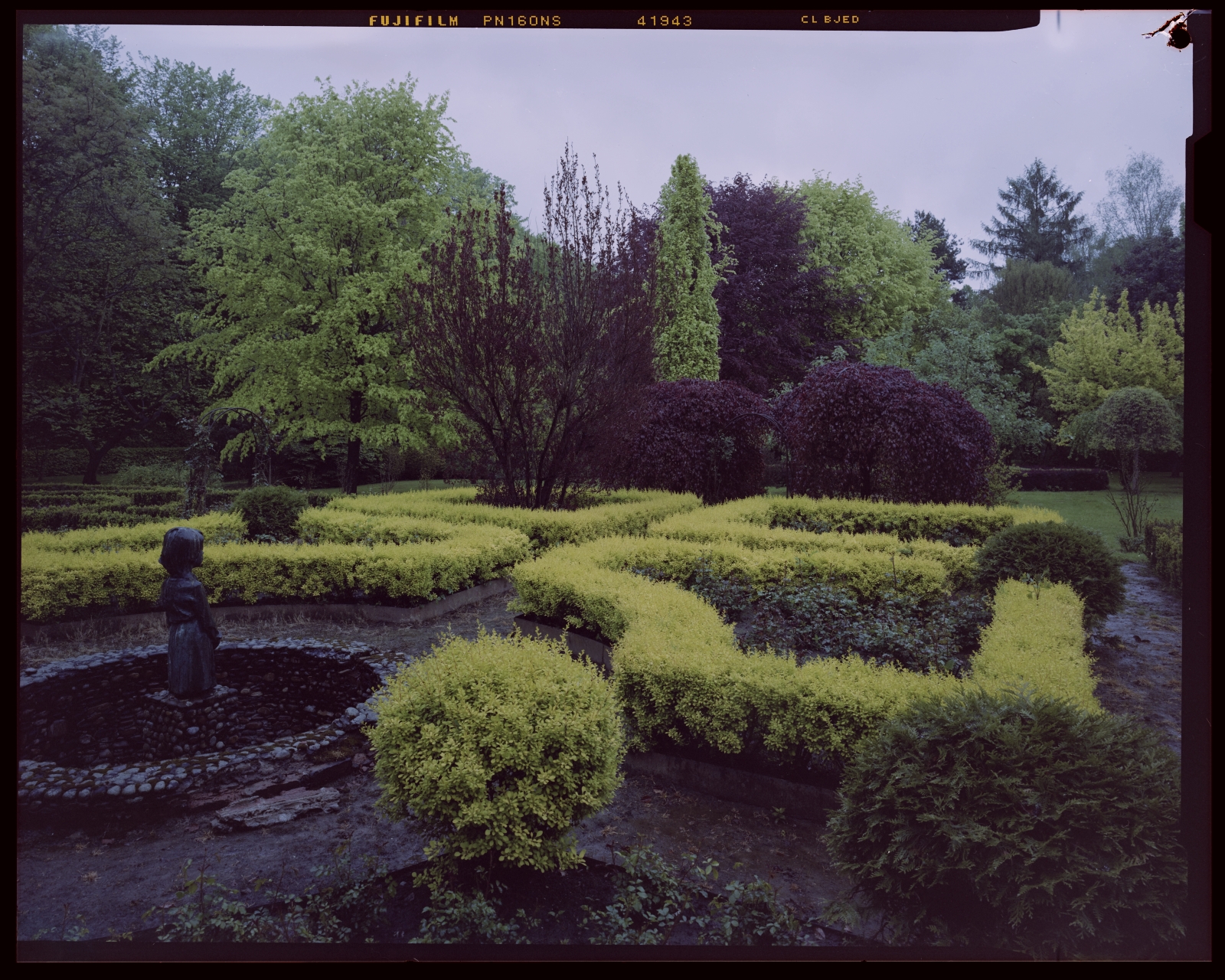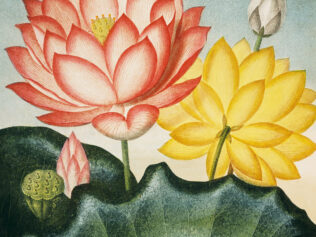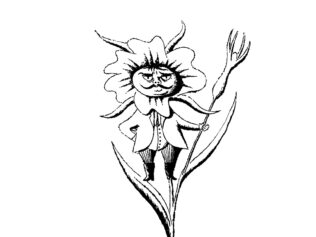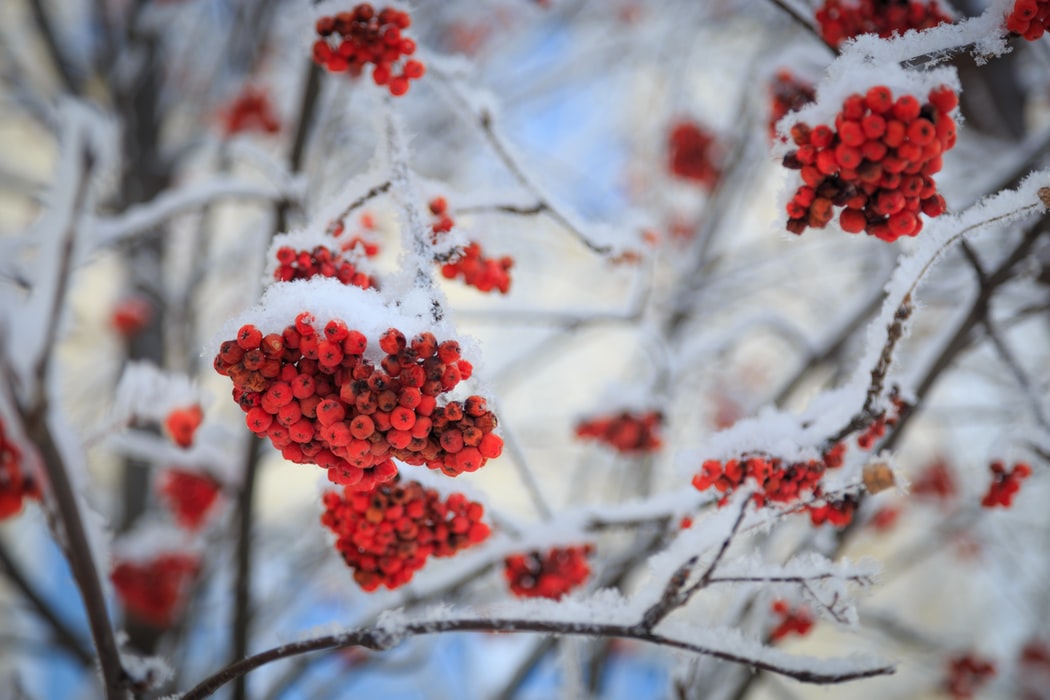
In early spring, forsythia flowers can appear on the menu. Raw. And a little later, pickled daisies, fried roses and ground violets join the table.
The flower is in fact the sex organ of a plant. Its role is reproduction. Note that Syreniusz’s Herbarium (Szymon Syreński, 1540–1611) – the most comprehensive and famous Polish herbarium, published at the start of the 17th century – advises thus: “The swollen male testicles are wrapped in daisy flowers.”
A plant is comprised of roots, stems, leaves, fruits and flowers. Flowers develop and create seeds, from which the next generation grows, and then they die. Eating flowers is quite simply a way of using the whole product and not just some culinary whim. Of course, sometimes part of a plant is inedible or downright poisonous. For example, you can eat Robinia pseudoacacia flowers (also known as black locust or false acacia; the honey that bees make from its flowers is commonly known as acacia honey), but its fruits and leaves are toxic.
Syrup from the housekeeper
You can eat your fill of flowers because they are in fact also commonly-used vegetables, such as cauliflower, broccoli and artichoke. Their culinary usage seems obvious to us. Courgette flowers and pumpkin flowers can be fried (and they taste delicious dipped in batter and deep fried). You can also stuff them with feta cheese or cream cheese, or coat them with breadcrumbs or ground almonds before frying.
Rose water and rose petals are very common in the Middle East and India, but also in Eastern Europe. Ewa Mitowska, owner of the Mitowska Homestead in Sterdyń, Mazovia province, and an authority on the folk and culinary traditions of the region, gathers pink-violet French rose petals, which she makes into a syrup with lemon juice. This stops the petals from turning blue and keeps their colour. “I have a recipe from between the wars. Our parish became Roman Catholic again after the First World War. Before that there was a (Greek-Catholic) Uniate and Orthodox church. The priest’s housekeeper asked the women from the village to gather sweet briar (Rosa agrestis) and she herself collected French rose petals from the many bushes growing next to the church. She mixed these flowers together to make a syrup-based jam. She taught the local women this method. Two years ago, in a competition called ‘Our Culinary Heritage, Tastes of the Regions’, I won first prize for that very rose syrup and we want to get it onto the official list of traditional products. It’s best with tea; it’s too strong for doughnuts. You can also eat it right off the spoon, because it’s delicious.”
Pick, pickle, ferment
Flowers have been around on planet Earth for more than 145 million years. Many of them smell nice due to their pollen or nectar, or the essential oils in their petals. The smell says to insects, Hey there! I’ve got lots of pollen. You can eat here. So, it works like an advertisement. Usually, flowers smell strongest in the morning, when they open to receive their insectile guests. There are others that have intense fragrance at night, to lure moths and other nocturnal creatures. Typically, these night flowers have more powerful fragrances in order to help the bugs find them in the dark. Each species of plant produces a particular number of essential oils, from seven to 100, whose combination gives each flower its own unique fragrance.
“Why would someone eat flowers?” I ask Justyna Pargieła, who is a qualified herbalist and phyto-therapist, and a graduate of the Institute of Monastic Medicine in Katowice. She has been vegetarian for 26 years, is passionate about wild cooking and herbs, and, for five years, ran a health food shop. Of course, she pickles daisies. She runs the DziczeJemy (‘We Eat Wild Things’) fan page and organizes workshops and lectures. Justyna replies: “Our great, great grandparents’ knowledge about flowers and herbs was enormous; wild plants were a large part of their diet. Lime flowers, clover and elderflower all ferment brilliantly, so they made cordials out of them. However, dandelion flower syrup is a newer thing. The buds of dandelions or nasturtiums are pickled like capers; and you can also pickle wild garlic flowers.”
When picking flowers for eating, we must remember that they contain pollen, which is very high in protein and very nutritious. In fact, pollen is the most valuable part of the flower. This is why, if we pick them for eating, we should only do so from unpolluted places, because they should never be washed, so as to preserve the pollen. We don’t pick flowers from fields we don’t know; large arable fields are normally sprayed. Justyna’s advice is as follows: “You can eat what you grow in your own garden, e.g. sterile sunflowers. Daisies can be sprinkled on salads, or you can pickle, marinate or crystallize them. It’s worth letting rucola flower; it has tingling, sharp-tasting flowers.”
Violet-scented sugar
You can use flowers usually thought of as decorative in cooking. Kasia Latos from the Latosowo agri-tourism farm says: “We’ve got several plots of sweet violets near here. A couple of years ago we started to collect both the leaves and the flowers. Unfortunately, picking the flowers is time-consuming and not very efficient – and you can only pick them in spring. Their seasonality means that we never have enough flowers to make sufficient preserves. But the leaves can be picked every month while they are green, although the spring ones are best, like all baby vegetables. We dry the leaves and some of the flowers and use them to make infusions, or mix them with other herbs, or just use them on their own. We grind up the flowers with sugar to make jam. We also make so-called violet sugar: lots of sugar, not many flowers; this combination, when toasted, gives you a beautiful violet-coloured sugar with a floral aroma. Unfortunately, this smell disappears if you heat the sugar again, so it should only be used uncooked. Sweet violet flowers have many essential oils, as does Rosa rugosa (or the damask rose), which is the best rose for cooking. The sweet violet has many health properties. It contains salicylic acid and flavonoids. It acts as an expectorant, a diaphoretic (it makes you sweat), a diuretic, antiseptic, increases bile production and works as a muscle relaxant.
“You shouldn’t just rush about hurriedly picking every flower. Pick too many now and there won’t be any fruits later. That’s why we pick around one third of the flowers at most, so that we don’t interrupt the plant’s development. Timing is also important. The flower is at its best when its blooming. It has the most pollen in the morning once the dew has dried off. Any plant that we are planning to eat part of should be healthy, unpolluted and undamaged. Once picked, the flower should be placed in a linen bag. If you want to dry them out, they should be laid out on a linen cloth and left in a warm, airy place. Dried flowers can be stored in a paper bag.”
The flower fizzes in the mouth
You can pick edible flowers yourself in your own garden or in the wild. There are also large-scale growers of culinary flowers such as pansies, roses and begonias, but you can also buy amaranth, Bougainvillea, monkey flowers (Mimulus) and fuchsia. At the request of a teenage friend, I once decorated a whole birthday cake with edible rose flowers. It was not in the middle of winter, so please don’t worry.
Once, large flowers (such as marigolds) ruled, but now the smallest flowers are sought after, like garlic or alyssum. Natalia Lewandowska, owner of Fusion Gusto, says: “The strangest, most original flower we offer is the Sichuan button, or buzz button flower. It is small, and looks like a yellow button. When you eat it, it is like having a fizzy sweet in your mouth; your salivary glands start to work faster and it cleans the tongue of other flavours. This flower is used during tasting dinners, in between courses.”
I once tried that flower; it was an experience somewhere between the pleasant fizzing of orange-dust and a stiff tongue. An advanced course in floral sensations.
You are part of nature
There are still masses of wildflowers about and you can even eat them while you are walking. Krystyna Stepczyńska-Szymczak, who has worked for over 30 years in the Faculty of Botanics and Ecology in today’s University of Science and Technology in Bydgoszcz, used to conduct field trips in addition to theory lessons. An expert in the anatomy, life cycle and chemical composition of many species, she began culinary experiments with wild plants. Increasingly, people wanted to hear about them and this led naturally to the creation of her Nature Academy, where she holds a series of meetings in the meadow with lovers of bloodless hunting. Stepczyńska-Szymczak says: “In spring-time there are many plants that flower very early, before any of the early vegetables. All you have to do is sprinkle your meals with flowers to make them more nutritious. Forsythia, one of the earliest flowers, has yellow flowers with a honeyed, intense flavour. It contains valuable plant mucilage (a sticky secretion) and has the highest levels of the flavonol rutin and vitamin C of all our flora. I encourage you to sprinkle your food with forsythia flowers. They flower so briefly that they don’t have time to absorb pollution from the air; you can even pick them from the heart of a city park or garden. Another spring flower is wood sorrel. These days its leaves are often added to give a bit of acidity to dishes, but you can also use the delicate, white, veiny flowers, which taste slightly more delicate than the leaves (in general flowers taste like their leaves). It is similar with coltsfoot; the leaves and flowers have masses of mucilage which are necessary for good digestion.”
Wild plants have to fight for their existence. This is why they create relevant dyes, waxes, resins, mucilage and tannins. There are not as many biologically active compounds in crops, but these are substances that we need in order to digest our food properly. We are an element of nature. What grows naturally is most healthy for us. Bend over and you will have the healthiest garnishes right to hand. Just look down.
I drew on material from, among others, “Rośliny w wierzeniach i zwyczajach ludowych. Slownik Adama Fischera, [Plants in Folk Beliefs and Customs: Adam Fischer’s Dictionary], compiled by Monika Kujawska, Łukasz Łuczaj, Joanna Sosnowska and Piotr Klepacki.
Annex
Poisonous flowers – which flowers should you avoid eating? Azalea, periwinkle, sweet peas, hyacinth, hydrangea, iris, lily of the valley, marsh marigold, oleander, delphinium, clematis, lobelia, anemone, daffodil and narcissus.
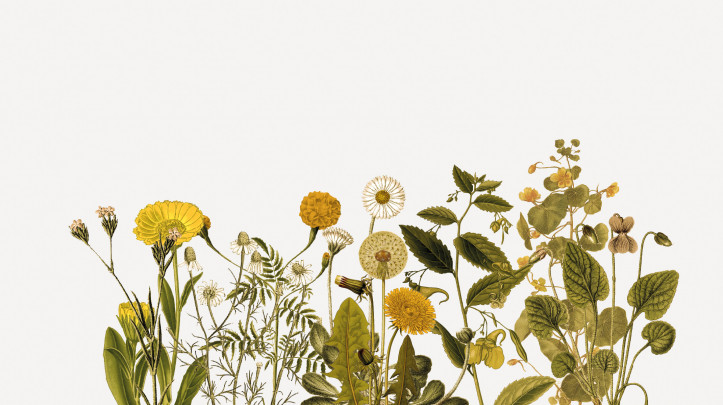
The edible flowerbed
Marigold
(Calendula officinalis L.)
Widely grown in gardens, it also grows wild. Orange or yellow-orange flowers. Used to colour milk or butter. Medicinally used in creams for ulcers and wounds, as an infusion for anaemia, and it ‘protects the pregnant against miscarriage’.
Carnation
(Dianthus caryophyllus)
In Poland many varieties are grown in gardens, some with a pleasant fragrance. Known as the common carnation or carnation.
This is a mighty herb. According to folklore it even helps with “dreadlocks: break off the head of this flower, soak in vodka or wine and wet the head where you have the knotted hair and it will untangle very quickly…” (Radziszów, Kraków County, Seweryn Udziela).
Chamomile
(Matricaria chamomilla L.)
According to the people of Ropczyce-Sędziszów County, chamomile grows from a blessed egg yolk thrown onto the ground in the garden. It is used medicinally for headaches, sore throats, as an infusion to ease breathing, and for cleaning eyes. Tea brewed from the flowers is drunk for coughs, colds and fever, to encourage sweating, for stomach complaints such as indigestion, bloating and diarrhoea, and to stimulate the appetite.
There is a superstition in the Kashubian region that says one shouldn’t pick chamomile on a Friday – an inauspicious day – because chamomile picked on a Friday loses its medicinal properties.
Common dandelion
(Taraxacum officinale)
Abundant in meadows, thickets and in towns. It has characteristic yellow flowers that, when still closed, can be marinated like capers. The open flowers are used to make wine and syrup. Dandelion is a rich source of vitamins B (B1, B2), A, C, and D, beta-carotene and minerals, including potassium. It is excellent for digestive problems, improves liver function, works as a diuretic, counteracts diabetes, helps with skin problems and boosts the immune system.
Impatiens
(Impatiens walleriana)
Impatiens (known as busy Lizzie in the UK) has masses of flowers, fires out its seeds and doesn’t need much looking after. The glands that secrete the fragrant nectar are found just by the leaf petioles. Its flowers have a balsamic, sweet flavour, which can be used to make puddings.
Sweet violet
(Viola odorata L.)
Growing wild in forests and thickets, it is commonly grown in gardens. It is often found in parks and on heathland. It is used medicinally for respiratory tract illnesses, either as an infusion or a tea, mainly for coughs and colds.
Marigold
(Tagetes)
A decorative flower, in Polish commonly called Turk, bull or stinker. Not just edible, but also very tasty. This flower, which festoons people’s balconies, has also appeared proudly on the plates of the exclusive Noma restaurant in Copenhagen. Mexican mint marigold, (or Texan tarragon), T. lucida, is used in the kitchen as a substitute for tarragon.
The above-ground parts of the plant are sometimes used to make medicines. Marigold is used for gastrointestinal complaints such as lack of appetite, flatulence, stomach ache, as well as for coughs and colds.
Nasturtium
(Tropaeolum majus)
The flower contains vitamin C, mineral salts and micro-elements. It has anti-bacterial and anti-fungal properties. It is also beneficial for the kidneys, urinary tract, liver, respiratory system and gall bladder.
Rose petal
(Rosa spp.)
In Poland, rose petals are used mainly in the Galicia region, from Kraków across Lesser Poland and further east. This custom came here from Arab countries. Rose petal jam is excellent for doughnuts. The petals are gathered in May, between two o’clock in the morning and dawn. At night-time they are firm and absorb a bit of dew and, as the sun begins to warm them, they go floppy. So, they must be picked before dawn and made into jam or blended raw with sugar within 12 hours. This type of jam is traditionally fried for three days. Natural petals are so bitter that you cannot make low-sugar products with them. The mixture must have a minimum sugar content of 65%.
Common lilac
(Syringa vulgaris)
It makes an excellent spice or cake ingredient, but is not really suitable as a standalone meal. Eaten on their own, the flowers have a slightly bitter, heavy taste, but they make dishes more digestible.
Common daisy
(Bellis perennis L.)
Commonly found in meadows, pastures and on roadsides all over the country. Daisies from unpolluted soil contain flavonoids, proteins, sugars, beta-carotene, vitamin C and mineral salts. Daisy tea helps with coughs, and an infusion is used as a medicine for chest diseases and women’s complaints.
Translated from the Polish by Annie Jaroszewicz

